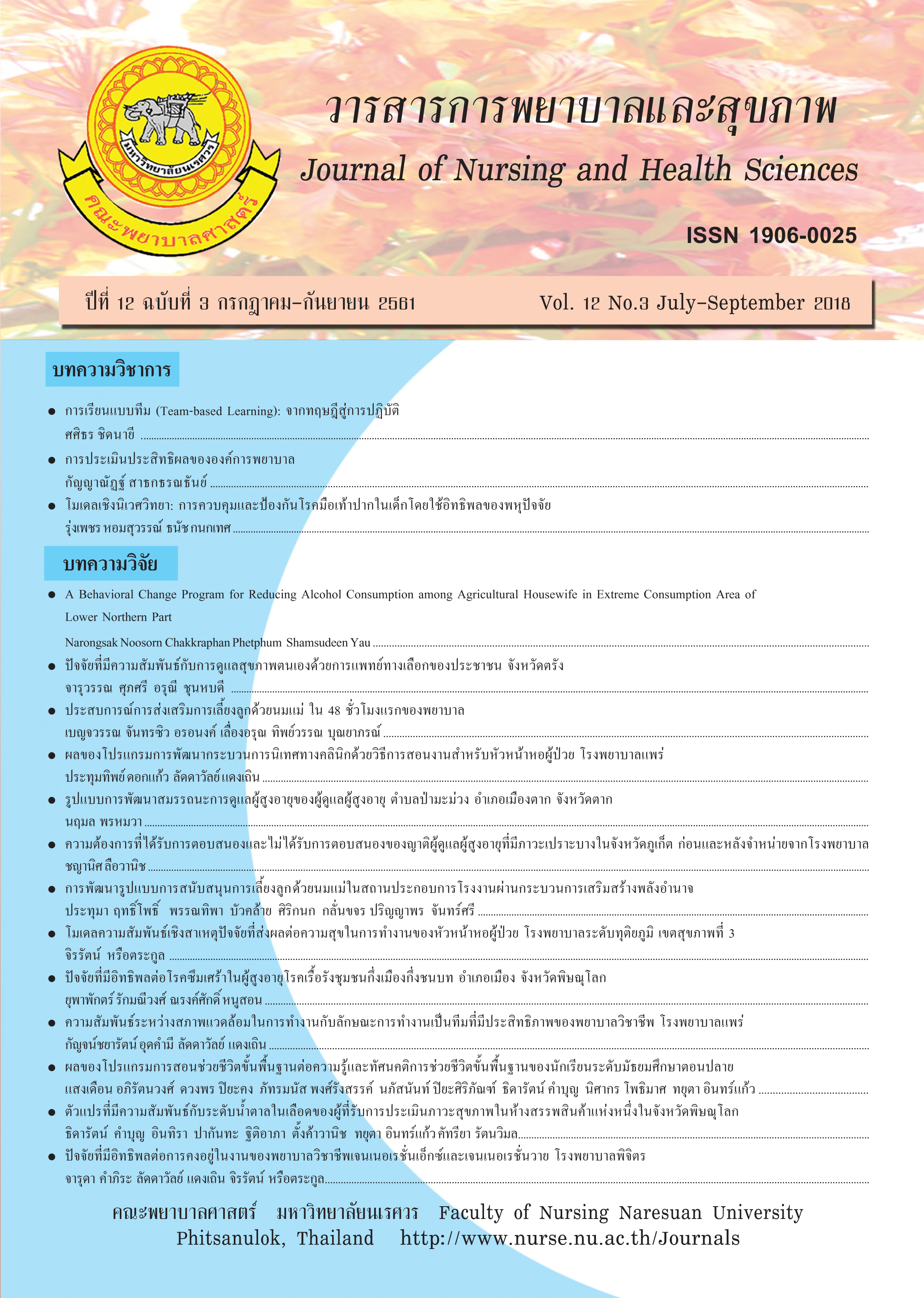โมเดลเชิงนิเวศวิทยา: การควบคุมและป้องกันโรคมือเท้าปากในเด็กโดยใช้อิทธิพลของพหุปัจจัย
Main Article Content
บทคัดย่อ
โรคมือเท้าปากเป็นโรคติดต่อที่พบได้บ่อยในเด็กและส่งผลกระทบทั้งต่อตัวเด็กที่เจ็บป่วยและ ผู้ปกครอง รวมถึงหน่วยงานที่เกี่ยวข้อง การควบคุมและป้องกันการแพร่กระจายเชื้อโรคมือเท้าปากในเด็ก เป็นสิ่งสำคัญและควรพิจารณาถึงปัจจัยต่างๆที่เกี่ยวข้องอย่างครอบคลุม ในอดีตที่ผ่านมาการแก้ไขปัญหา การแพร่ระบาดของโรคนี้ส่วนใหญ่มุ่งความสนใจไปที่ปัจจัยภายในบุคคลและปัจจัยระหว่างบุคคล ทั้งนี้ หากพิจารณาในเชิงลึกยังพบว่ามีปัจจัยอื่นที่เกี่ยวข้องกับพฤติกรรมสุขภาพซึ่งส่งผลต่อการควบคุมและ ป้องกันการแพร่กระจายเชื้อโรคมือเท้าปากในเด็ก ดังนั้นการใช้กรอบแนวคิดที่ครอบคลุมปัจจัยทุกระดับ ที่มีอิทธิพลต่อการปรับเปลี่ยนพฤติกรรมสุขภาพ เช่น โมเดลเชิงนิเวศวิทยา (Ecological Model) ในการ พิจารณาแนวทางการแก้ไขปัญหาดังกล่าว อาจช่วยแก้ไขปัญหาสุขภาพของเด็กกลุ่มเสี่ยงนี้ได้อย่าง มีประสิทธิภาพมากยิ่งขึ้น ทั้งนี้เพราะโมเดลเชิงนิเวศวิทยานี้มีความโดดเด่นในด้านของกระบวนการแก้ไข ปัญหาสุขภาพด้วยการใช้อิทธิพลร่วมกันของพหุปัจจัยเช่น ความรู้ การปฏิบัติ เครือข่ายและการสนับสนุน ทางสังคม องค์กร นโยบายต่างๆ เป็นต้น ที่มีความเฉพาะเจาะจงต่อพฤติกรรมสุขภาพ และปฏิสัมพันธ์ ข้ามระดับของสิ่งแวดล้อมในระบบนั้นๆบทความนี้นำเสนอแนวคิดของการประยุกต์ใช้โมเดลเชิงนิเวศวิทยา ในการควบคุมและป้องกันโรคมือเท้าปากในเด็ก รวมทั้งจุดแข็งและข้อจำกัดซึ่งอาจช่วยให้ผู้สนใจมีความ เข้าใจและนำไประยุกต์ใช้ได้อย่างมีประสิทธิภาพต่อไป
Article Details
เอกสารอ้างอิง
ก า ร ป ร ะ เ มิน ศูน ย์เ ด็ก เ ล็ก ป ล อ ด โ ร ค .
กรุงเทพฯ : โรงพิมพ์ชุมนุมสหกรณ์การเกษตร
แห่งประเทศไทย.
กรมควบคุมโรค กระทรวงสาธารณสุข. (2557). มาตรการ
ป้องกันควบคุมโรคติดต่อสำคัญช่วงเปิดเทอม.
สืบค้นจาก http://www.beid.ddc.moph.go.th/
th_2011/upload/files/moe170657.pdf
ณัฐวุฒิ อุดมสารี,และธนัช กนกเทศ. (2560). ปัจจัยที่มี
ความสัมพันธ์ต่อพฤติกรรมการป้องกันโรคมือ
เท้าปากของผู้ปกครองเด็กในศูนย์พัฒนาเด็กเล็ก
เขตตำบลชุมตาบง อำเภอชุมตาบง จังหวัด
นครสวรรค์. การประชุมวิชาการระดับชาติ
มหาวิทยาลัยราชภัฏเพชรบูรณ์ ครั้งที่ 4 ณ
มหาวิทยาลัยราชภัฏเพชรบูรณ์, 616-623.
ดาราวรรณ รองเมือง, ฉันทนา นาคฉัตรีย์, พุทธิดา
รอดศรี, วรารัตน์ กลับชุ่ม, วิราวรรณ ทองสุข,
ศรสวรรค์ เพชรคงทอง, สิรินันท์ สร้อยฟ้า.
(2556). การใช้สื่อการ์ตูนแอนิเมชั่น 2 มิติ เพื่อ
ป้องกันโรคมือเท้าปากในเด็กวัยก่อนเรียน: ความรู้
ในการปฏิบัติตัวเพื่อป้องกันโรค. วารสารเครือข่าย
วิทยาลัยพยาบาลและการสาธารณสุขภาคใต้,
1(1), 29-41.
ทัศนีย์ พาณิชย์กุล, พิสุทธิ์ ปทุมาสูตร, และสุภาวดี
สมบูรณ์. (2012). การหยุดเรียนลดการ
แพร่กระจายของโรคมือเท้าปากในโรงเรียน.
วารสารวิจัย มสด สาขาวิทยาศาสตร์และ
เทคโนโลยี, 5(2), 1-12.
พันธ์ชัย รัตนสุวรรณ.(2561). ตำราระบาดวิทยาสำหรับ
นักศึกษาแพทย์และนักศึกษาวิทยาศาสตร์
สุขภาพ มหาวิทยาลัยวลัยลักษณ์. Retrieved
from https://www. smd.wu.ac.th/wp-content/
uploads/ 2017...pdf
ภัทร วาศนา, และอดิศักดิ์ สัตย์ธรรม. (2558). ประสิทธิผล
ของการเรียนรู้โดยใช้กิจกรรมตามบริบทที่เน้น
ความเสี่ยงและการสนับสนุนทางสังคมในการ
ส่งเสริมป้องกันโรคมือเท้าปาก ในศูนย์พัฒนา
เด็กเล็ก.สมาคมสถาบันอุดมศึกษาเอกชน
แห่งประเทศไทยในพระราชูปถัมภ์สมเด็จ
พระเทพรัตนราชสุดาฯ สยามบรมราชกุมารี, 4(2),
7-18.
วิภาดาแสงนิมิตชัยกุล, และปรีย์กมล รัชนกุล. (2015).
ปัจจัยทำนายพฤติกรรมป้องกันการติดต่อโรคมือ
เท้าปากของผู้ดูแลเด็กในสถานรับเลี้ยงเด็กเล็ก
วัยก่อนอนุบาลและผู้ปกครอง. รามาธิบดี
พยาบาลสาร, 21(3), 336-351.
สำนักระบาดวิทยา กระทรวงสาธารณสุข. (2555).
แนวทางการดำเนินงานป้องกัน ควบคุมการ
ระบาดของโรคมือเท้าปาก. สืบค้นจาก http://
www. thaigcd.ddc.moph.go.th/uploads/pdf/
baby/13.7.58/Measure_HFM.pdf
สำนักระบาดวิทยา กระทรวงสาธารณสุข. (2561).
สถานการณ์โรคมือเท้าปาก.สืบค้นจาก http://
www.boe.moph.go.th/boedb/surdata/disease.
php?ds=71
สุภาภรณ์ ประยูรมหิศร, อะเคื้อ อุณหเลขกะ, และ
จิตตาภรณ์ จิตรีเชื้อ. (2556). การพัฒนาชุด
การเรียนรู้ด้วยตนเองในการป้องกันการติดเชื้อ
สำหรับผู้ดูแลเด็กในศูนย์พัฒนาเด็กเล็ก.
พยาบาลสาร, 40(4), 34-44.
อุดมลักษณ์ เพียรสุขเวช, และ พรรณี บัญชรหัตถกิจ.
(2557). ผลของโปรแกรมสุขศึกษาในการป้องกัน
โรคมือเท้าปาก ในวัยเด็กโดยการประยุกต์
แบบแผนความเชื่อด้านสุขภาพและแรงสนับ
สนุนทางสังคมของผู้ดูแลเด็กและผู้ปกครองเด็กใน
ศูนย์พัฒนาเด็กเล็ก อำเภอเมือง จังหวัดขอนแก่น.
ศรีนครินทร์เวชสาร, 29(2), 158-163.
Center for Disease Control and Prevention. (2016). Hand,
Foot, and Mouth Disease (HFMD). Retrieved
from https://www.cdc.gov/hand-foot-mouth/
index.html
Chan, J.H., Law, C., Habilon, E., Fung, H. & Rudge, J.
(2017). Best practices to prevent transmission
and control outbreaks of hand, foot, and mouth
disease in childcare facilities: a systematic
review. Hong Kong Med Journal, 23(2), 177-
189. Retrieved from: http://www.hkmj.org
Christensen, J. (2016). A critical reflection of
Bronfenbrenner’s development ecology model.
Problems of Education in the 21st. Century,
69(22), 22-28. Retrieved from: http://
www.scientiasocialis.lt/pec/node/1001
Glanz, K., Rimer, B. K., & Viswanath, K. (2015). Health
Behavior Theory, Research, And Practice
5th ed. San Francisco: Jossey-Bass A Wiley.
Guy, L. (2007). The Ecological Model: An Overview
for Advocates. In Partners in Social change,
9(3), 4-6. Retrieved from: http://www.Wcsap.org
Krebs, R. J. (2009). Bronfenbrenner’s Bioecological
Theory of Human Development and the process
of development of sports talent. International
Journal of Sport Psychology, 40(1), 108-135.
Li, Z., Lai, S., Zhang, H., Wang, L., Zhou, D., Liu, J.,
Yang, W. (2014). Hand, foot and mouth disease
in China: evaluating an automated system for
the detection of outbreaks. Bulletin of the World
Health Organization, 92, 656-663. doi: 10.2471/
blt.13.130666
McLeroy, K. R., Bibeu, D., Steckler, A., & Glanz, K.
(1988). An Ecology Perspective on Health
Promotion Programs. Health Educational
Quartery,15(4),351-376. Retrieved from https://
www.researchgate.net/profile/Kenneth
Mcleroy/publication
Ruan, F., Yang, T., Ma, H., Jin, Y., Song, S., Fontaine,
R. E., & Zhu, B. P.(2011). Risk Factors
for Hand, Foot, and Mouth Disease and
Herpangina and the Preventive Effect of
Hand-washing. Pediatrics, 127(4), e898-e904.
Sallis, J. F., &Owen, N.(2015). Ecological Models of
Health Behavior. In K. Glanz, B.K.Rimer, &K.
Viswanath (Eds.). Health behavior: theory,
research, and practice5thed. (pp. 43-61.).
San Francisco: Jossey-Bass A Wiley.


